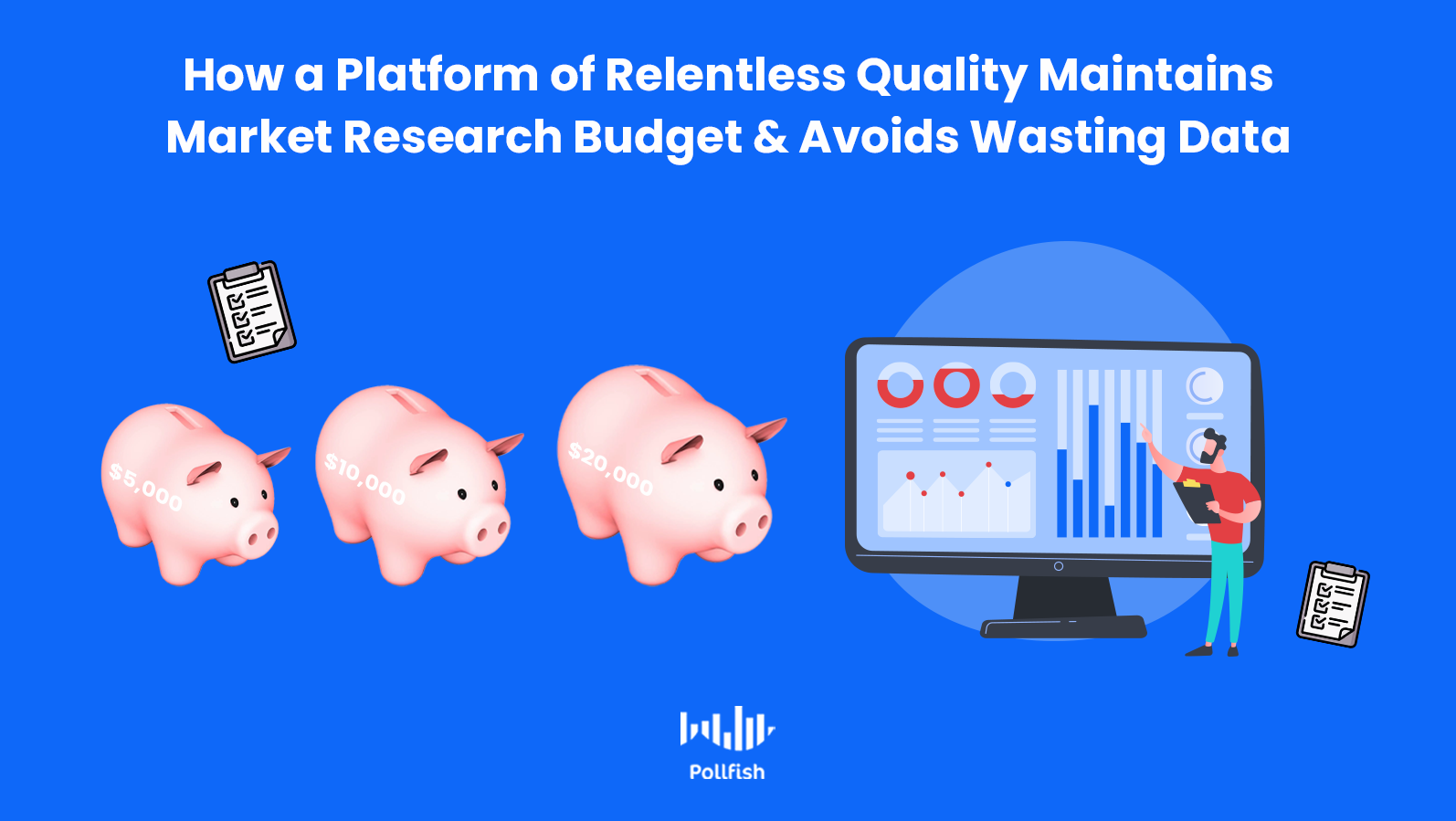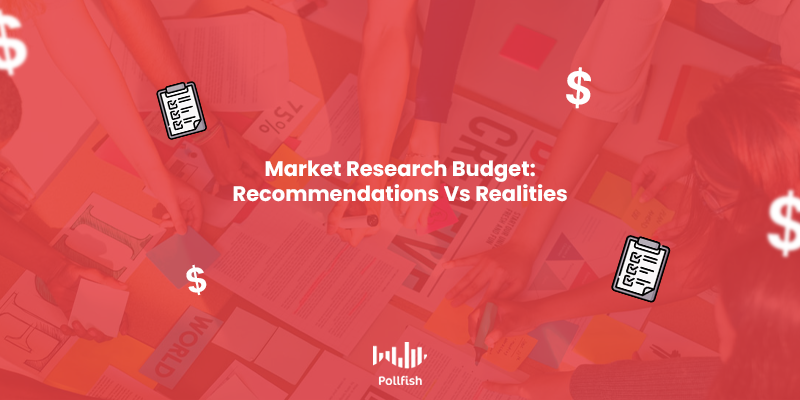Maintaining a Market Research Budget with a Platform of Relentless Quality

While many businesses rely on a set marketing budget, few allocate funds specifically towards a market research budget. This is troubling, as it shows that budgeting for market research is secondary if not completely swept under the rug.
When businesses aren’t heedful to a market research budget, they either fall behind on their market research needs or wind up over-spending — and it shows in the numbers, as businesses spend up to $50,000 on market research alone.
But does high marketing spend yield considerable profits for businesses? Are they obtaining a steady ROI on their investments? And most importantly, are their market research investments bringing them any value?
This article delves into the market research budget and how a market research platform that offers relentless quality can support it to its maximum potential.
Understanding the Market Research Budget
Despite the importance of market research, many businesses forgo budgeting towards it, which can carry several consequences, including the aforesaid risks of over-spending or ignoring market research in its entirety.
First off, it is crucial to fully understand the market research budget along with its associations.
A market research budget is a portion of designated funds set aside for market research specifically. In regards to its portion aspect, this budget itself is a portion of a marketing budget, which includes all the subsets of marketing, specifically the kinds that are used by a business, as not all businesses will use the same marketing functions.
The following lists several key components of a marketing budget:
- Market research
- Advertising
- Branding
- Brand tracking, brand equity
- Public relations (PR)
- Website development and redesign
- Website management
- SEO and SEM
- Content marketing
Market research requires its own budget, given its importance to a business’s success and the various market research techniques, components, tools and methods. Much like with a marketing budget, not all businesses will require all using all the items in this budget.
The following enumerates the key considerations in a market research budget:
- Qualitative market research
- Quantitative market research
- Syndicated research
- Field Research
- Focus groups
- Interviews
- Survey panels
- An online survey platform
Market Research Budget Recommendations Vs. Actual Market Research Expenditures
The overall expenditure in a market research budget is chiefly dependent on the business that intends to conduct market research. However, there are still some recommendations and guidelines for setting up a solid market research budget.
Firstly, businesses should design a marketing budget, as this is the encompassing budget that will include all market research plans. As such, businesses should settle on a specific amount to cover all of their marketing-related activities.
Beginning at the broader marketing budget level, the U.S. Small Business Administration recommends a marketing spend of 7-8% for businesses, that is, if a company has a net profit margin of 10-12% after all expenses.
This recommended range, however, is not the reality for businesses across various verticals. Businesses are allocating between 8-12% of their funds towards marketing, according to a study by the marketing insights firm CMO Survey.

High-growth technology companies and SaaS businesses in particular, run the highest expenditures, with a whopping 80-120% of their revenue being funneled towards marketing.
As far as market research spending in particular, there are specific spending guidelines for different market research assets. According to marketreseach.com, researchers should divide expenditures for projects based on these assets in the following categories:
Full-Market Reports $1,500 – $8,000, most commonly $3,500 – $4,000)
Product Detail Market Reports $15,000 – $35,000
However, both syndicated research and custom research providers can offer subscription-based services that can run businesses into plans in the tens of thousands. In fact, some market research projects cost up to $100 thousand, with average costs existing in the $35-55,000 range.
Evidently, businesses spend too much on their market research efforts, exceeding many of the recommendations of a marketing and more specifically, a market research budget.
Unused and Underused Data
Given that the recommendations for a market research budget and the reality of business expenditures do not line up, businesses have to rethink their market research budget. But most importantly, businesses must reconsider their entire market research efforts.
Why is that? Because while many businesses claim to be data-driven and even go so far as to assert that they use agile data, their data provides very little use. This is because, in an attempt to prove these claims, businesses amass large quantities of data that is left unused.
Also known as dark data, most of the data that businesses collect, be it via market research, web analytics or other means, goes unused. 68% of data is not used by businesses who invest in it — that’s over two-thirds of data gone to waste.
But there’s much more to data than the data itself, which is often the result of a market research project. That’s because dark data is a manifestation of wasted efforts. When businesses have two-thirds of underused or unused data, the following has essentially been squandered:
- Planning
- Meetings across teams and within departments
- Finding a market research method
- Finding a market research tool
- Money allotted towards the research
- Time spent conducting the research
- Survey data analysis (if the data was slightly used, but not to its full potential)
There is a major disconnect between the data that a business thinks it needs and the data it uses when over two-thirds of data is never looked at or underused. But the chief concern, in this case, is what the point was in actively planning, amassing and retrieving data when most of it goes unused.
Only a market research platform that is heavily focused on the quality of the research can resolve these issues. Therefore, such a platform optimizes all aspects of its market research techniques.
Relentless Quality to Fortify a Market Research Budget & Remedy Unused Data
A market research provider, such as an online survey platform can avoid poor market research budgeting, gaps in data usage and even the accuracy of the extracted data. But it must provide relentless quality.
Unfortunately, swaths of online survey tools account for the 68% of dark data (percentage of unused data) that they provide for businesses. These platforms are not all designed to suit a market research budget, especially their enterprise plans, which can run for thousands of dollars a month.
Effectively, the patrons of these market research providers are spending thousands on their data a month and exceeding maximum expenditures on research budget guidelines — all while abandoning 68% of their data.
In turn, dark data goes beyond exhausting the funds in a market research budget, as it creates damage in an overall market research campaign. This damage to market research includes:
- Inaccurate and bias-riddled data
- This is because researchers must analyze all of their data, certainly not just 32% of it.
- An enlarged margin of error
- Being a poor representation of a target market with no basis for statistical significance
- An incapability of making informed predictions and perform prospective research
- Difficulty to take action or make changes

When a survey platform or other market research provider offers an approach with relentless quality, it can avoid and overcome all of these obstacles. Thus, such a platform can avoid unused data and a waste of time, money, resources, et. al.
A platform that offers relentless quality brings first-rate quality to all aspects of the research process — from a massive network of publisher sites and apps to the dashboard of the platform, to the way the data is collected and presented.
When all points of the research provide optimal quality, researchers and the businesses they work for are not left wondering what went wrong, which answers are faulty, why it takes a long time to aggregate the data and more.
Thus, researchers can set up a market research budget properly and actually be able to adhere to it without compromising the quality of their research.
Deciding on a Market Research Platform that Provides Relentless Quality
When opting for a market research provider, businesses ought to turn to a provider that offers relentless quality through a number of ways. The Pollfish platform delivers on the promise of relentless quality.
First off, businesses can maintain a market research budget while performing various campaigns, as the Pollfish platform is one of the most affordable ones in the online survey platform niche.
The platform deploys surveys in a vast network of top online sites and apps and does so with a mobile-first agile data approach. Businesses, therefore, gain quick results even when distributing surveys to a large sample size, such as one with thousands of respondents.
The data is processed with artificial intelligence and machine learning to avoid survey fraud, biases, low-quality answers, the margin of error and other issues that mar the quality of the data. Thus, the data itself is of a high quality.
It is presented on a user-friendly dashboard that makes it easy to interpret the data. Thus, this is going to be seen as less of a chore that market researchers put off… and off, indefinitely. Researchers can also integrate Pollfish with other SaaS providers should researchers prefer to consolidate their data analysis.
When the data is quickly extracted, avoids faulty respondents and is easy to deploy and use, businesses are naturally more likely to use it. Thus the Pollfish platform offers an augmented survey experience, one that suits many market research budgets and campaigns at large.
Frequently asked questions
Why is having a market research budget important for businesses?
A market research budget should be derived from an overall marketing budget because a lack of research may lead to overspending or inefficient allocation of resources.
What are some key considerations in a market research budget?
The key characteristics of a market research budget include expenditures in qualitative research, quantitative research, field research, focus groups, interviews, survey panels, and online survey platforms.
How should businesses set up a market research budget?
First, determine the overall marketing budget because research would go under this banner. Next, identify your objectives. Know what kind of information you need, if it's proactive or reactive, and who gets to use this info. After that, study available market research and reports to see if they fulfill your informational needs. And finally, report these findings to the decision-makers to prioritize market research as one of their financial goals for the upcoming year.
What are the consequences of unused data in market research?
Unused data may lead to inefficient planning, money wasted on market research, and unnecessary meetings. It may even skew research results causing further damage. Therefore, businesses should know the difference between knowing how much data they need and how much data will be left unused once they've used it.
What should businesses consider when deciding on a market research platform?
A robust online survey platform should offer a myriad of features and draw out quality data. Moreover, it should be fully customized for the questionnaire and screener, deploy the survey to intended individuals, seamlessly filter the data once the survey is completed, and leverage artificial intelligence to carry out quality checks that eradicate poor quality data. The platform should also provide valuable customer data and insights with several easy-to-use question formats, advanced skip logic, RDE, mobile-first design, etc., enabling a business to make data-driven decisions.
Do you want to distribute your survey? Pollfish offers you access to millions of targeted consumers to get survey responses from $0.95 per complete. Launch your survey today.
